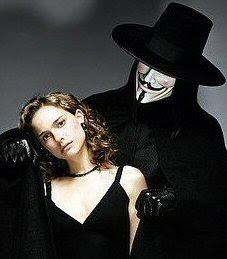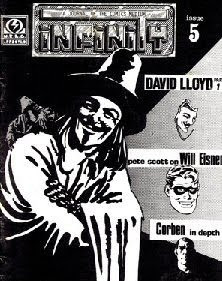V for Vendetta (1982-85, 88-89)
V FOR VENDETTA (2006)
An appealing portrait for V FOR VENDETTA, depicting V in a Phantom of the Opera-like enveloping of Evey.
WRITTEN by Alan Moore and illustrated by David Lloyd, the comic strip V for Vendetta debuted in the launch issue of Warrior in March 1982. Set in (the then) distant 1997, it depicts a Britain which has been spared from nuclear destruction, but is ruled by the fascist Norsefire regime, who have restored peace at the cost of personal freedom and privacy. This government have rounded up and killed everyone they consider subversive – blacks, gays and radicals – leaving a docile and scared populace held by a combination of a super-computer (state-owned radio broadcasts its propagandistic and reassuring lecture to the people as ‘The Voice of Fate’) and the secret police (‘Fingermen’). Into this mix arrives V, an anarchist and terrorist in a Guy Fawkes mask, who is enacting an elaborate and specific revenge. Speaking largely in rhyme, quotation and lyric, V rescues young Evey Hammond from the secret police, and introduces her to the ‘Shadow Gallery,’ an underground hideout filled with his large collection of banned and suppressed books, music and art.
Although the original impetus for its dystopian vision was a passionate protest against Thatcherite greed and anti-unionism, the story is a cocktail of influences as disparate as Orwell’s Nineteen Eighty-Four and THE ABOMINABLE DR PHIBES. V for Vendetta’s ideological struggle still stands amongst the best of Moore; it works as a detective story, futuristic thriller and an action adventure, yet V’s brand of faceless and remorseless violence seems as dictatorial as the fascist ideal. V blows up buildings and is a cold-blooded murderer, torturer and manipulator. If ordinary people are caught within this struggle, the suggestion is that they have made their own cage. But beyond V’s rebellious aims he also reminds about identity and integrity. Change may be painful, but V channels and directs his anarchy to a specific goal – ultimately, the character becomes more than his menagerie of ideas, he becomes a force, pursuing his vendettas and preaching his values until his vision is vindicated. This is why Evey becomes V at the end of the story; while the first V was a destroyer, the next V will be a teacher and builder of the cause.
V’s actual appearance - a Guy Fawkes papier mache mask, cape and conical hat – was the idea of artist David Lloyd. Here V is the cover story from issue 5 of the comics fanzine Infinity, published in 1984.
The film version, written and produced by the Wachowski brothers and directed by their former assistant James McTeigue, adds nothing to the original and subtracts a great deal – most crucially, Moore’s paean to anarchism. Too much of the political fable falls back on posing and fireworks, unsurprisingly turning the comic’s grim and grey 1980s into a IMAX-friendly technological sheen. Evey (Natalie Portman) is no longer a factory waif on the point of prostitution, but an office girl (a new sub-plot involving Stephen Fry as a gay rebel is as pointless as it is irritating). Worthy of note, however, is Hugo Weaving as V, in what must have been the least sought-after leading male role of the season. Purring lengthy speeches with the insidious tones of a 1970s TV voiceover, his body language and head-tilts effectively convey seething emotions behind his immobile mask.


